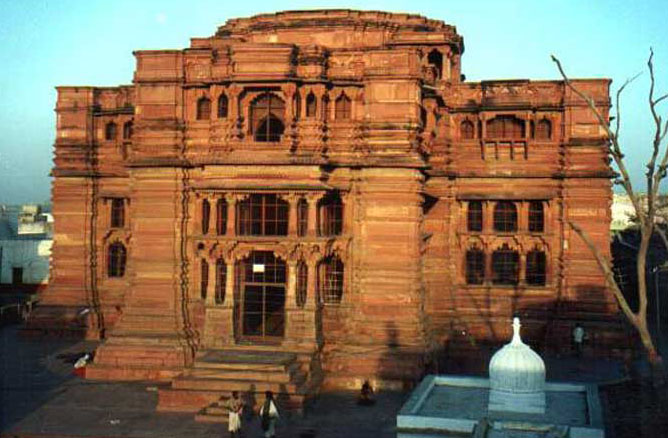Govind Dev Ji Temple

Information of Govind Dev Ji Temple, Vrindavan, Mathura, Uttar Pradesh
Govind Dev Ji Temple is one of the important and sacred places of Vrindavan. It is also known as Temple of Radha Govinda. Govind Dev Temple was created by king Man Singh in the year 1590 who was inspired by Rupa Goswami. The building of the temple is situated in the core of main Vrindavan town at Govindaji road. The establishment of Govind Dev Temple is believed to be related with prominent journey by Emperor Akbar in the year 1573. At present, Govind Dev Temple is regarded as one of the four temples which were erected for the tribute of King Akbar's tour to the holy place Vrindavan.
Govind Dev Ji Temple Religious Significance
Govind Dev Temple is regarded as king Man Singh's best known construction plan. The temple was the biggest construction created in Northern India in 12th century. It is believed that in the year 1573, King Akbar visited Vrindavan and on the basis of tradition, Hindu emperors convoyed him and attained his authorisation to create Govind Dev Temple. At present, Govind Dev Temple is empty and behind the temple, there is a small Govind Dev Temple where replica of original deity of lord Govinda is worshipped. This small Govind Dev Temple is believed to be created by the disciples of Chaitanya from West Bengal. They were also the first priests of Govind Dev Temple. The original deity of lord Govinda is worshipped in Jaipur city of Rajasthan. Nevertheless, there is a record of utilising the original Govind Dev Temple for religious celebrations for example gathering of Mahamandala. During the festivals such as Janmasthami and Holi, the entire temple complex is decorated with flowers and other religious components.
Govind Dev Ji Temple Mythology & History
According to legend, before 5000 years, the grandson of lord Krishna named Vajranaba installed several vital idols in Vrindavan and lord Govinda is regarded as one of them. The tradition of worshipping lord Govinda is severely personal which state the sovereignty of Govinda with the identification of Radha-Krishna. During the period of 1709 to 1748, Gareeb Nivaz, an emperor of Manipur took Krishnaism and practiced this religion for about 20 years. From that time, Manipuri Vaishnavas do not worship lord Krishna alone, rather they worship the pair Radha-Krishna which is also known as Govinda. In Vaishnavism, worship of Radha was established by the followers of Rupa Goswami, an Indian religious teacher of Vaishnav tradition. Eventually this act of worshipping Radha Krishna spread and becomes dominant in the entire region.
In Chaitanya tradition, lord Krishna appears as lord Govinda. Early evidence of worshipping lord Govinda can be found in 4th century BC in accordance with the indication of Megasthenes, a Greek ethnographer. In accordance with the study of Klaus Klostermaier, a Hindu researcher, lord Govinda is the outcome historical procedure which resulted from contemporary Krishnaism. Krishnaism follows the original fad of Krishna, Vasudev and Radha which dates back to multiple eras. In this context, it can be stated that Govind Dev Temple is one of the key temples where Radha and Krishna are worshipped in various forms.
Govind Dev Ji Temple Architectural Significance
Govind Dev Temple possesses an imposing structure created by marble and silver. The ceiling of the primary hall of the temple is ornamented with a sculptured lotus which weighs over multiple tons. The temple is an example of feudal Indian architecture. The building of Govind Dev Temple is popular and its shape is quite familiar to the churches of Europe. The inner arches and columns of the temple were inspired by various regal sites, but was technically much inventive in comparison with Man Sing's own building.
- Andhra Pradesh Temples
- Assam Temples
- Bihar Temples
- New Delhi Temples
- Goa Temples
- Gujarat Temples
- Jammu and Kashmir Temples
- Karnataka Temples
- Kerala Temples
- Madhya Pradesh Temples
- Maharashtra Temples
- Odisha Temples
- Punjab Temples
- Rajasthan Temples
- Sikkim Temples
- Tamil Nadu Temples
- Telangana Temples
- Uttar Pradesh Temples
- Uttarakhand Temples
- West Bengal Temples